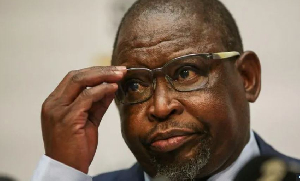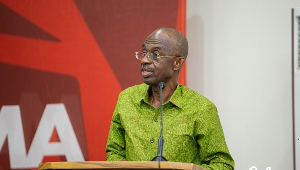Rivers play significant roles in human lives, but over the years, human activities coupled with a changing climate which manifests through erratic rainfall pattern and increasing temperature, have contributed to pollution and silting of rivers and water channels, thereby threatening flora and fauna.
Significant human activities that have disturbed water channels include private and public Infrastructural developments, most of which serve as human settlements close to rivers and water channels.
Other activities are the felling and cutting of trees around river banks for domestic use, and to pave the way for agricultural activities. It is also common to find in most of these areas, mining activities, and more especially around rivers and streams.
Encroachment means the act of trespassing, the act of violation or invasion into areas specifically allocated for protection.
In the Bolgatanga Municipality is the “Kolaa” water shed. ‘Kolaa’, which literally means “water bowl”, falls within the White Volta basin. This is located along the Zuarungu / Bawku trunk road. Along these areas are settlements with many more springing up alongside other economic activities.
Communities situated close to the water channel is the Sawaaba community heavily inhabited by different tribes such as Hausas, Malians, Nigerians and some natives of the Upper East Region.
Also close to the water resource, are the Metro Mass Transport (MMS) loading points, a block factory close to the river channel and on the Bawku /Bolgatanga Trunk road are located the Tindonseo, Yarigabiisi and Kumbosco communities among others. Agricultural activities prevalent around the source of water channel are irrigation and farming, predominantly undertaken during the dry and rainy seasons.
The ‘Kolaa’ water channel over the years, has experienced flooding, due to heavy rains and spillage of water from the Bagre dam in Burkina Faso, with the first of its kind in 1999, and the worst occurring in 2007, where many lives and property were lost due to backlog of water.
Among the worst hit areas of the floods in 2007 were Sawaaba and outlining communities in the Bolgatanga Municipality, and the region as a whole.
This phenomenon of flooding has become a perennial issue in these communities where people living in the low lying areas have to go through the “ritual” of floods and its impact.
This perennial occurrence has become a growing concern because life and property are vital and its effects on the economy need not be over emphasized. These climatic problems give indications that river bodies are also vulnerable to the impact of climate change.
Ghana, among other countries in the world, is culpable to climate variability. Effects of the impact have been felt by all people from all walks of life and calibre, with rippling effects on the National purse.
In the 2007 floods, Government according to a Guide Book on Climate Change, written by the Environmental Protection Agency and NADMO, spent GHC 6,200,000 on flood relief victims in the Northern sector, central and western regions. A clear indication is that things are not being done right.
Mr Aaron Aduna, White Volta Basin Officer of the Water Resources Commission (WRC) in the Upper East Region describes a basin as a whole area that drains into a common channel.
The indication is that when it rains, the water has to find its way into drains, through the smaller rivers or tributaries and end up in the White Volta River.
This natural beauty of the flow of water has been challenged due to obstructions put in the ways of its flow, leading to backwaters, hence forcing its way through other alternatives. However, according to the White Volta Basin Officer, “We all live in a river basin and it is part of our ecological address,” he added.
Therefore, the need to look critically into encroachment activities around the “Kolaa” water resource in the Bolgatanga Municipality and all other water channels in the basin is vital and can help prevent future disasters.
Giving insight into the 2007 floods in Upper Region, the water expert said it was one of the terrible floods bringing in its wake, disasters in the entire region, and added that the recent springing up of houses, churches and schools in the “Kolaa” area was becoming alarming and a threat not only to human beings, but to the water body.
Mr. Aduna who is also a hydrologist noted that the channel was no longer a well-defined one, because of the level of development/obstruction that has taken place around it.
Explaining how these affected the water resource, he said “Anything that affects the water body affects the entire water basin” and added that it made it difficult to project data on the water resource for future planning purposes.
“Abnormal movements of the water due to the blocking causes back water flow and that is what destroys or causes flooding since the water would have to force its way through other means”. Mr Aduna said.
Major difficulties residents of communities around the area face are well opened up drains that will enhance channeling of water flow.
Though water is important in domestic use and livestock watering, it maintains environmental health too. When micro-organisms die off as a result of pollution and siltation, it leaves its effects on the water bodies. Pollution of rivers and streams due to poor sanitation leads to disease outbreak, common among them are typhoid and cholera, among others.
Mr. Aduna said when sewerage systems are poorly designed and built, they can also cause leakages of fecal matter, draining into water resource and that will pollute and as well destroy any life within the water.
The Water Resources Commission established by an Act of Parliament (Act 522 of 1996) as the overall body responsible for water resources management in Ghana, has the mandate to manage and regulate the use of water resources and to co-ordinate relevant government policies in relation to them.
Mr. Aduna said the WRC collaborates with other institutions such as the Environmental Protection Agency, and the District Assembly among others, to manage this resource.
In an advice, the White Volta Basin Officer said in areas where continuous floods occur, the best action to take is to zone the entire area, not for infrastructural development, but have opened drains for the flow of water.
In this regard, efforts to protect and improve water quality and regenerate vegetation along river bodies have started in earnest, using the riparian buffer zones policy to implement, manage and control activities along river banks and surface water bodies.
Mr Asher Nkegbe, Upper East Regional Director of the Environmental Protection Agency (EPA) stated in an interview that 2,000 hectares of land along water bodies was being earmarked for the establishment of buffers in selected districts of the region as efforts to protect rivers.
As all efforts are being made by government and stakeholders to address these environmental problems, growing concerns of overlapping roles and responsibilities of some institutions and traditional land owners are a worry worth-noting.
Areas of most concern are lands close to water channels given out by land owners for development. Whilst developers require such services from the Town and Country Planning Department to demarcate the areas, it should interest them, as stakeholders of development, to ensure the protection of areas preserved as no-go areas.
Administrative challenges, lack of collaboration by some departments also contribute to the level of despair and disinterest. The offices of Parks and Gardens, established by government and responsible for the development of the nation’s landscape and the preservation and beautification of the environment look on when edges of roads are covered with bush, making vision difficult on roads. Meanwhile the department’s role in the environmental and sanitation management in the country is vital.
Will the contribution of the Forestry Commission be limited to Forest Reserves, while wild fires and encroachments on wildlife protected areas as a result of illegal farming activities continue to occur? The buffer zones effectively need the collaboration of all especially communities to make the policy a success.
Good collaboration between some Agencies and Departments are also needed to promote good environmental standards in the country.
Opinions of Friday, 31 October 2014
Columnist: Fatima Anafu Astanga



















